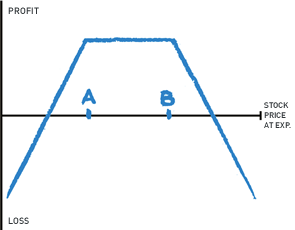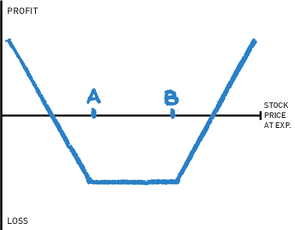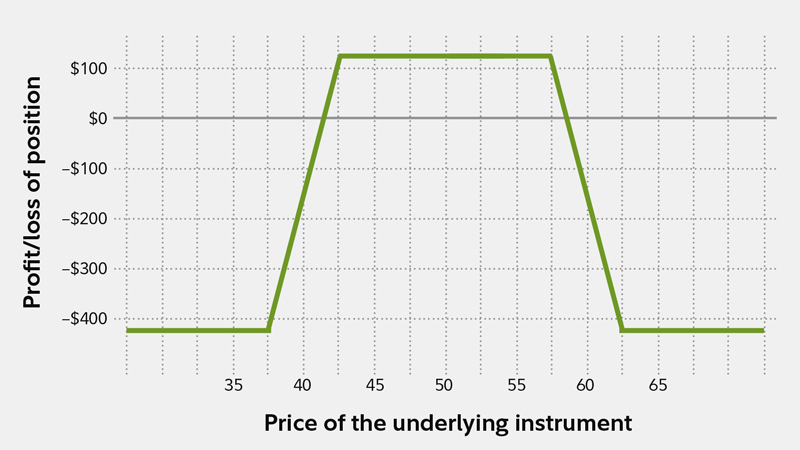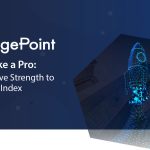Understanding The Power Of Iron Condors in Options Trading
When traders first start trading, they get excited by potential reward. They recognize that if they are correct in forecasting the future direction of price correctly they can earn nice profits. However, traders who have been through numerous bull and bear market cycles, eventually gravitate toward high probability income strategies that offer limited risk and limited rewards.
These tactics require an understanding of the basic of Options trading but, once these fundamentals are understood, the opportunities are endless in being able to create high probability income strategies from the financial markets. One of these tactics is referred to as an Iron Condor.
I have written about a handful of Options strategies which you can study in greater depth by reading those articles here, here and here.
The best way to understand Options Trading is to think of the insurance business.
Any insurance contract will insure you for a specific amount of coverage, for a specific amount of time. In exchange for this protection, you will be required to pay a premium payment to the insurer.
Since Options are instruments that are only good for a specified period of time, they are considered to be deteriorating assets. All things being equal, an Option will be worth less tomorrow than it is today, simply because it is closer to the expiration date.
An Option is recognized as a deteriorating asset by savvy traders who use this understanding to create strategies that provide additional income to their portfolio while hopefully also minimizing risk.
A buyer of an Option has rights. To receive those rights, they will have to pay a premium payment to the Option seller.
A seller (creator) of an Option has obligations. They will be required to offset their position or fulfill their obligation if the market works against them.
What this means is, you can be the insurer and collect Option premiums in your account. However, before you do so, you need to understand that should the market move adversely, you will be required to either close out your position with a corresponding loss or fulfill the obligation that you created.
Selling Options for income is one of the few strategies where you can be completely wrong about the direction of the market and still win. This is because an Option is a deteriorating asset, and the premium will deteriorate exponentially the closer the Option is to the expiration date. By no means does this mean it is not risky. A seller of a put Option is obligating themselves to own the stock at the agreed upon strike price between now and the expiration date.
The reality is that longer-term markets have a tendency to trend about 33% of the time. The remaining 66% of the time they normally end up trading on very broad trading ranges. This usually presents a problem from trend-based traders. In this environment, Options traders have a distinct advantage when they learn how to sell time with limited risk.
Let me explain with an example.

Any way you look at the chart above you will conclude it is a sideways market, sometimes called sideways drift. This occurs when asset prices fluctuate within a tight range for an extended period of time without trending one way or the other. Sideways markets are typically described by regions of price support and resistance within which the price oscillates for an extended period of time. Trading a sideways market can be tricky, but certain Options strategies maximize their potential payoff in these instances.
Traders who think an underlying security’s price will remain in a sideways trend by expiration, and want to limit their risk, could consider constructing an Iron Condor. The benefit of this strategy is it generally allows a trader to generate a larger premium, while limiting potential loss. One way to think of an Iron Condor is of owning a long strangle inside of a larger, short strangle—simultaneously. The following two diagrams show you the simplicity of this trade:
Here is the Short Strangle:

Short Strangle
Here is the Long Strangle:

When you combine the four Options together you create a limited reward, with limited risk strategy that is essentially selling time and anticipating that volatility remains dormant.
The strategy is constructed as follows:
- Buy one Out of The Money (OTM) put with a strike price below the current price of the underlying asset. This put option will protect against a significant downside move to the underlying asset.
- Sell one At The Money (ATM) put with a strike price closer to the current price of the underlying asset.
- Sell one At The Money (ATM) call with a strike price above the current price of the underlying asset.
- Buy one Out of the Money (OTM) call with a strike price further above the current price of the underlying asset. This OTM call option will protect against a substantial upside move.
If you are new to trading Options this will appear complicated. Rest assured that all we are doing here is creating two credit spreads which bring income premium into the account. As long as the price of the underlying stock at expiration is between the two lower strike prices you will keep the entire premium on the trade. The worst-case scenario/risk is that if the market decides to breakout and begin trending again you will experience a maximum loss of the difference between the strike prices less the credit you received.
Assume that on June 1, XYZ Company is trading at $50. To construct an Iron Condor, a trader would purchase one July $40 put with a $0.50 premium at a cost of $50 ($0.50 premium times 100 shares controlled by the one contract) and one July $60 call with a $0.50 premium at a cost of $50 ($0.50 premium times 100 shares controlled by the one contract). At the same time, to complete the iron condor a trader would sell one July $45 put with a $1 premium at a credit of $100 ($1 premium times 100 shares controlled by the one contract) and one July $55 call with a $1 premium at a credit of $100 ($1 premium times 100 shares controlled by the one contract).
Buy 1 July 40 Put at .50 debit $50
Buy 1 July 60 Call at .50 debit $50
Sell 1 July 45 put at 1.00 credit $100
Sell 1 July 55 call at 1.00 credit $100
Net Credit of $1.00 has been collected.
The strategy is designed to generate a small profit, and while the potential loss is larger than the profit potential, the loss is capped. This can be visualized through the following diagram:

As long as the price remains between $40 on the downside and $60 on the upside a profit will occur. (This is a huge range, which is what makes it a very high probability trade.) But more importantly, it is essential to practice good risk management techniques, which means that in a worst-case situation, if the price breaks out of its sideways channel, you will lose $4 per share or $400.
When you breakdown this tactic down to its absolute essentials you are offsetting the bullishness of a super bull with the bearishness of a super bear. As long as the price ends up in between the two higher strike prices it generates a profit. This is how professional traders SELL time with limited risk.
It is not uncommon for Iron Condor traders to experience winning percentages well above 90% when they implement this strategy. This is because it allows for a very wide trading range to unfold at expiration and still be profitable. We always encourage Options traders to protect themselves whenever they sell time and collect premium. Great trading is never about how much money you make when you are correct, but rather how little you lose when you are wrong. You must be aware when trading Iron Condors that you can lose 4x more than you can earn on this strategy.
Choosing the proper strike prices is crucial to being successful with the iron condor. It is important to understand the trade-off between the probability of success and maximum profit potential.
Adding the Iron Condor to your trading arsenal could be very rewarding. Using the artificial intelligence to find these markets is paramount to your long-term success.
If you do believe a low volatility environment will persist, Iron Condors can be a powerful, limited-risk tactic to increase the ROI on your trading portfolio.
Do you want to learn how to use the Vantagepoint Software A.I. to find Iron Condor candidates? Our Intelliscan feature within the software will scan daily for candidates that are trapped in a sideways trading range.
This is where artificial intelligence comes in and why it is so powerful.
A.I., through advanced pattern recognition, analyzing tens of thousands of data points, and crunching millions of computations, finds the highest probability trades and is indispensable in separating fact from fiction.
Intrigued?
What all traders and investors want is an accurate, proven solution that alerts you when a high probability trade possibility is unfolding. The Vantagepoint A.I. forecasts have proven to be up to 87.4% accurate in determining the trend three days in advance.
Visit us and check out the A.I. at our Next Live Training.
It’s not magic. It’s machine learning.
Make it count.
THERE IS SUBSTANTIAL RISK OF LOSS ASSOCIATED WITH TRADING. ONLY RISK CAPITAL SHOULD BE USED TO TRADE. TRADING STOCKS, FUTURES, OPTIONS, FOREX, AND ETFs IS NOT SUITABLE FOR EVERYONE.IMPORTANT NOTICE!
DISCLAIMER: STOCKS, FUTURES, OPTIONS, ETFs AND CURRENCY TRADING ALL HAVE LARGE POTENTIAL REWARDS, BUT THEY ALSO HAVE LARGE POTENTIAL RISK. YOU MUST BE AWARE OF THE RISKS AND BE WILLING TO ACCEPT THEM IN ORDER TO INVEST IN THESE MARKETS. DON’T TRADE WITH MONEY YOU CAN’T AFFORD TO LOSE. THIS ARTICLE AND WEBSITE IS NEITHER A SOLICITATION NOR AN OFFER TO BUY/SELL FUTURES, OPTIONS, STOCKS, OR CURRENCIES. NO REPRESENTATION IS BEING MADE THAT ANY ACCOUNT WILL OR IS LIKELY TO ACHIEVE PROFITS OR LOSSES SIMILAR TO THOSE DISCUSSED ON THIS ARTICLE OR WEBSITE. THE PAST PERFORMANCE OF ANY TRADING SYSTEM OR METHODOLOGY IS NOT NECESSARILY INDICATIVE OF FUTURE RESULTS. CFTC RULE 4.41 – HYPOTHETICAL OR SIMULATED PERFORMANCE RESULTS HAVE CERTAIN LIMITATIONS. UNLIKE AN ACTUAL PERFORMANCE RECORD, SIMULATED RESULTS DO NOT REPRESENT ACTUAL TRADING. ALSO, SINCE THE TRADES HAVE NOT BEEN EXECUTED, THE RESULTS MAY HAVE UNDER-OR-OVER COMPENSATED FOR THE IMPACT, IF ANY, OF CERTAIN MARKET FACTORS, SUCH AS LACK OF LIQUIDITY. SIMULATED TRADING PROGRAMS IN GENERAL ARE ALSO SUBJECT TO THE FACT THAT THEY ARE DESIGNED WITH THE BENEFIT OF HINDSIGHT. NO REPRESENTATION IS BEING MADE THAT ANY ACCOUNT WILL OR IS LIKELY TO ACHIEVE PROFIT OR LOSSES SIMILAR TO THOSE SHOWN.










